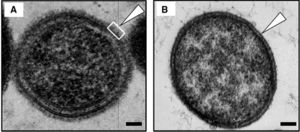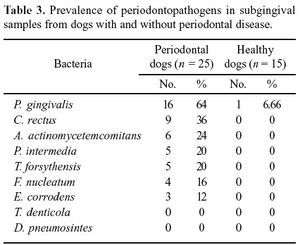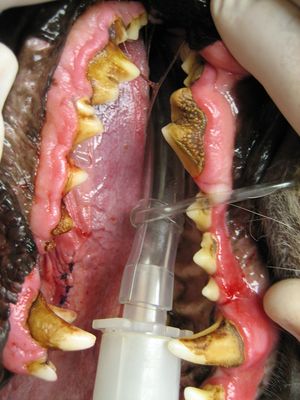Introduction
[]
Tannerella forsythia

(A) A wild-type T. Forsythia cell. (B) A mutant T. Forsythia cell that is S-layer deficient.
[1].
[]
Culture

Bacteria identified from culture of a dog with a periodontal disease. T. forsythia comprises 20% of the bacteria identified.
[2].
[]
Periodontal Diseases in Canines

Image of a dog with severe plaque and calculus buildup
[3].
[]
S-layer and BspA
Abscesses

Image of a severely infected abscess. Swelling has begun, along with redness surrounding the injury.
[4].
References
Jullian, Tim. "How to Brush Dogs' Teeth | Step by Step Guide | King West Vets." King West Vets. King West Vets Veterinary Clinic, 15 Jan. 2013. Web. 21 Apr. 2016.
"PetMD." Dog Gum Disease. PetMD, n.d. Web. 21 Apr. 2016.
Sketot, G. "Potential of the Tannerella Forsythia S-layer to Delay the Immune Response." Journal of Dental Reseearch (2010): n. pag. Web. 18 Apr. 2016. <http://jdr.sagepub.com/content/90/1/109.full>.
"Hand Infection." Hand & Reconstructive Microsurgery Center. National University Hospital, n.d. Web. 21 Apr. 2016. <http://www.handsurgery.sg/hand-infection.html>.
Tanner, Anne C. R., and Jacques Izard. "Tannerella Forsythia, a Periodontal Pathogen Entering the Genomic Era." Periodontology 2000 Periodontol 2000 42.1 (2006): 88-113. Web.
Yoo, Ji Yeon, Hyeong Chan Kim, Weidong Zhu, Seon-Mi Kim, Mojgan Sabet, Martin Handfield, Jeffrey Hillman, Ann Progulske-Fox, and Seok-Woo Lee. "Identification of Tannerella Forsythia Antigens Specifically Expressed in Patients with Periodontal Disease." FEMS Microbiology Letters 275.2 (2007): 344-52. Web. 23 Apr. 2016.
Ozbek, Selcuk M., and Ahmet Ozbek. "Real-time Polymerase Chain Reaction of “red Complex” (Porphyromonas Gingivalis, Tannerella Forsythia, and Treponema Denticola) in Periradicular Abscesses." Oral Surgery, Oral Medicine, Oral Pathology, Oral Radiology, and Endodontology 110.5 (2010): 670-74. Web. 18 Apr. 2016.
[Lee SW, Sabet M, Um HS, Yang J, Kim HC & Zhu W (2006) Identification and characterization of the genes encoding a unique surface (S-) layer of Tannerella forsythia. Gene 371:102–111.]
[Sharma A, Inagaki S, Honma K, Sfintescu C, Baker PJ & Evans RT (2005a) Tannerella forsythia-induced alveolar bone loss in mice involves leucine-rich-repeat BspA protein. J Dent Res 84:462–467.]
Nishiyama, Sheila Alexandra Belini, Gerusa Neyla Andrade Senhorinho, Marco Antônio Gioso, and Mario Julio Avila-Campos. "Detection of Putative Periodontal Pathogens in Subgingival Specimens of Dogs." Brazilian Journal of Microbiology Braz. J. Microbiol. 38.1 (2007): 23-28. Web. Apr. 2016.
"CDC: Half of American Adults Have Periodontal Disease | Perio.org." CDC: Half of American Adults Have Periodontal Disease | Perio.org. American Academy of Periodontology, n.d. Web. 24 Apr. 2016. <https://www.perio.org/consumer/cdc-study.htm>.
"Tannerella Forsythia." MicrobeWiki. N.p., n.d. Web. 24 Apr. 2016. <https://microbewiki.kenyon.edu/index.php/Tannerella_forsythia>.
Ratini, Melinda. "Abscess: Causes, Symptoms, Tests, and Treatment." WebMD. WebMD, 12 Oct. 2015. Web. 24 Apr. 2016. <http://www.webmd.com/a-to-z-guides/abscess>.
[Angata, T. & Varki, A. (2002). Chemical diversity in the sialic acids and related a-keto acids: an evolutionary perspective. Chem Rev 102, 439–470.]
[Varki, A. (1997). Sialic acids as ligands in recognition phenomena. FASEB J 11, 248–255.]
[Inagaki, S., Onishi, S., Kuramitsu, H. K. & Sharma, A. (2006). Porphyromonas gingivalis vesicles enhance attachment, and the leucine-rich repeat BspA protein is required for invasion of epithelial cells by ‘‘Tannerella forsythia’’. Infect Immun 74, 5023–5028.]
Homma, Kiyonobu. "Tannerella Forsythia- A New Intruder of the Human Periodontal Pocket." (n.d.): 1-2. Spotlight on a Lab. University of Buffalo. Web. 23 Apr. 2016. <http://wings.buffalo.edu/ubscientist/Kiyo_Epub09.pdf>.
[Sharma A, Inagaki S, Sigurdson W & Kuramitsu HK (2005b) Synergy between Tannerella forsythia and Fusobacterium nucleatum in biofilm formation. Oral Microbiol Immunol 20:39–42. Sharma A, S]
Sharma, Ashu. "Virulence Mechanisms of Tannerella Forsythia." Periodontology 2000 54.1 (2010): 106-16. Web. 24 Apr. 2016.
Nakajima, Takuma, Naoko Tomi, Yayoi Fukuyo, Hiroaki Ishikura, Yuka Ohno, Ramanathan Arvind, Takao Arai, Isao Ishikawa, and Shinichi Arakawa. "Isolation and Identification of a Cytopathic Activity in Tannerella Forsythia." Biochemical and Biophysical Research Communications 351.1 (2006): 133-39. Web. 24 Apr. 2016.
Roy, Sumita, C. W. Ian Douglas, and Graham P. Stafford. "A Novel Sialic Acid Utilization and Uptake System in the Periodontal Pathogen Tannerella Forsythia." Journal of Bacteriology. American Society for Microbiology (ASM), 26 Feb. 2010. Web. 24 Apr. 2016. <http://www.ncbi.nlm.nih.gov/pmc/articles/PMC2863479/>.
At right is a sample image insertion. It works for any image uploaded anywhere to MicrobeWiki.
The insertion code consists of:
Double brackets: [[
Filename: PHIL_1181_lores.jpg
Thumbnail status: |thumb|
Pixel size: |300px|
Placement on page: |right|
Legend/credit: Electron micrograph of the Ebola Zaire virus. This was the first photo ever taken of the virus, on 10/13/1976. By Dr. F.A. Murphy, now at U.C. Davis, then at the CDC.
Closed double brackets: ]]
Other examples:
Bold
Italic
Subscript: H2O
Superscript: Fe3+
Introduce the topic of your paper. What is your research question? What experiments have addressed your question? Applications for medicine and/or environment?
Sample citations: [1]
[2]
A citation code consists of a hyperlinked reference within "ref" begin and end codes.




